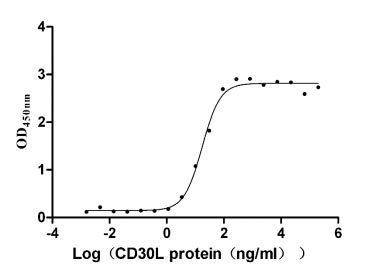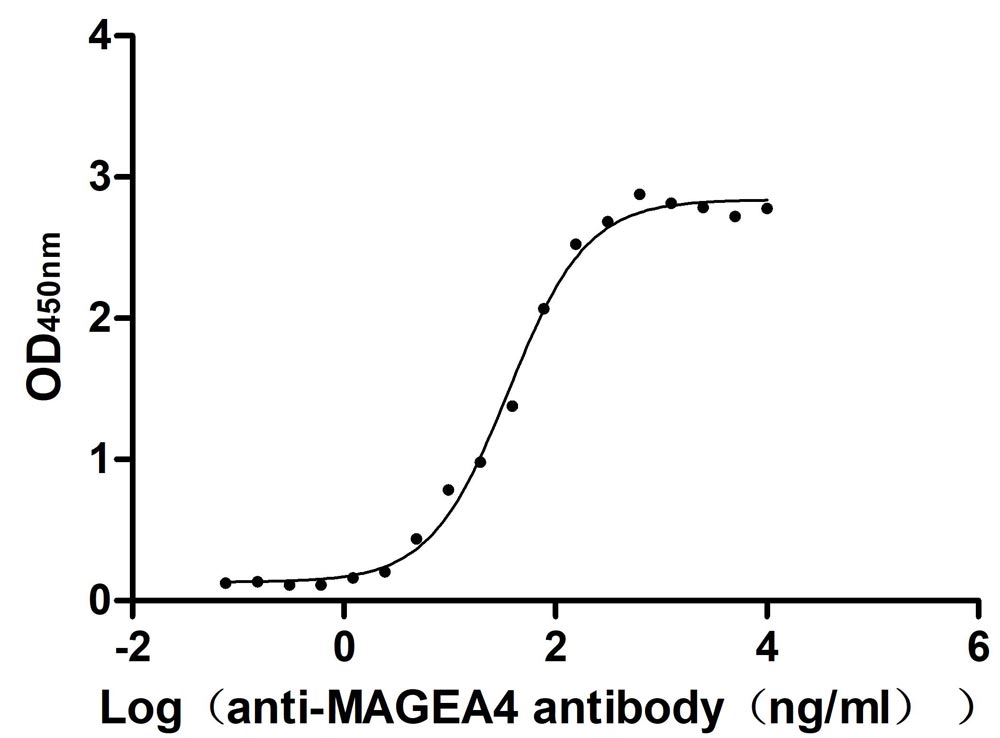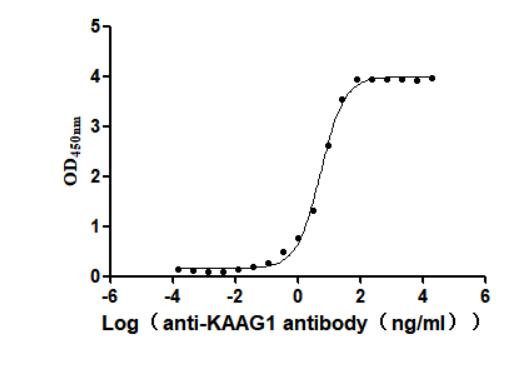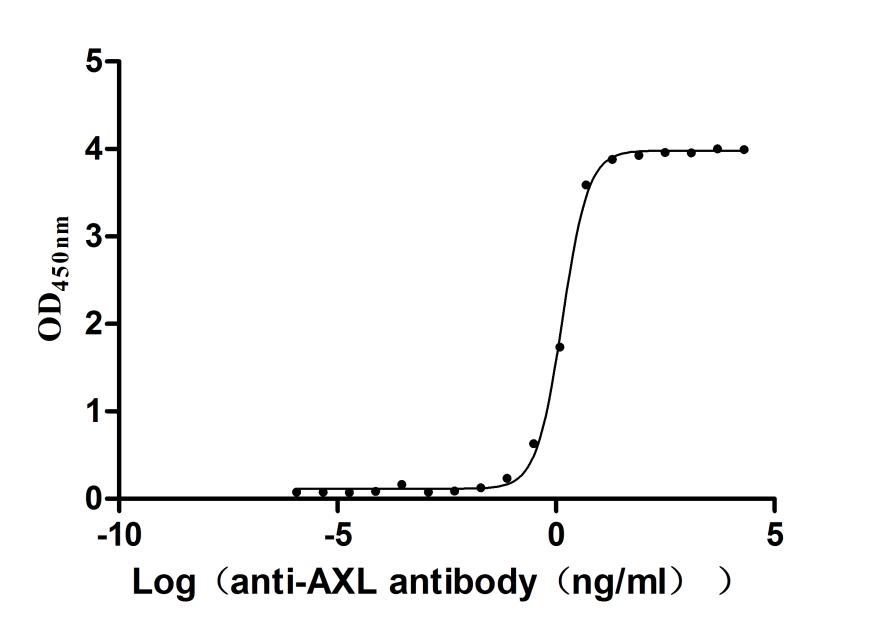Recombinant Human Gastrotropin (FABP6)
-
中文名称:人FABP6重组蛋白
-
货号:CSB-EP007955HU
-
规格:¥1344
-
图片:
-
其他:
产品详情
-
纯度:Greater than 90% as determined by SDS-PAGE.
-
基因名:
-
Uniprot No.:
-
别名:Fabp6; FABP6_HUMAN; Fatty acid binding protein 6; ileal (gastrotropin) ; Fatty acid-binding protein 6; Gastrotropin; GT; I 15P; I BABP ; I BALB; I BAP; I-15P; I-BABP; I15P; IBABP ; IBALB; IBAP; ILBP; ILBP3 ; Ileal lipid binding protein; Ileal lipid-binding protein; ILLBP ; Intestinal 15 kDa protein; Intestinal bile acid binding protein; Intestinal bile acid-binding protein
-
种属:Homo sapiens (Human)
-
蛋白长度:Full Length of BC022489
-
来源:E.coli
-
分子量:41.4kDa
-
表达区域:1-128aa
-
氨基酸序列MAFTGKFEMESEKNYDEFMKLLGISSDVIEKAHNFKIVTEVQQDGQDFTWSQHYYGGHTMTNKFTVGKESNIQTMGGKTFKATVQMEGGKLVVNFPNYHQTSEIVGDKLVEVSTIGGVTYERVSKRLA
Note: The complete sequence including tag sequence, target protein sequence and linker sequence could be provided upon request. -
蛋白标签:N-terminal GST-tagged
-
产品提供形式:Liquid or Lyophilized powder
Note: We will preferentially ship the format that we have in stock, however, if you have any special requirement for the format, please remark your requirement when placing the order, we will prepare according to your demand. -
缓冲液:Tris-based buffer,50% glycerol
-
储存条件:Store at -20°C/-80°C upon receipt, aliquoting is necessary for mutiple use. Avoid repeated freeze-thaw cycles.
-
保质期:The shelf life is related to many factors, storage state, buffer ingredients, storage temperature and the stability of the protein itself.
Generally, the shelf life of liquid form is 6 months at -20°C/-80°C. The shelf life of lyophilized form is 12 months at -20°C/-80°C. -
货期:Basically, we can dispatch the products out in 1-3 working days after receiving your orders. Delivery time may differ from different purchasing way or location, please kindly consult your local distributors for specific delivery time.Note: All of our proteins are default shipped with normal blue ice packs, if you request to ship with dry ice, please communicate with us in advance and extra fees will be charged.
-
注意事项:Repeated freezing and thawing is not recommended. Store working aliquots at 4°C for up to one week.
-
Datasheet & COA:Please contact us to get it.
相关产品
靶点详情
-
功能:Binds to bile acids and is involved in enterohepatic bile acid metabolism. Required for efficient apical to basolateral transport of conjugated bile acids in ileal enterocytes. In vitro binds to bile acids in the order: deoxycholic acid > cholic acid > chenodeoxycholic acid and respective BA conjugation modifies affinities in the order taurine-conjugated > glycine-conjugated > unconjugated bile acids. Stimulates gastric acid and pepsinogen secretion.; Essential for the survival of colon cancer cells to bile acid-induced apoptosis. ...显示更多
-
基因功能参考文献:
- Structural determinants of ligand binding in the ternary complex of human ileal bile acid binding protein with glycocholate and glycochenodeoxycholate obtained from solution NMR PMID: 26613247
- Analysis of slow and fast motions in I-BABP indicates largely different energy landscapes for the apo and holo states suggesting that optimization of binding interactions might be achieved by altering the dynamic behavior of specific protein segments. PMID: 25073073
- show, using electrospray ionization mass spectroscopy, that human ILBP binds bile acids with a 3:1 ratio, even at low protein and ligand concentrations PMID: 23758264
- Ursodeoxycholic acid induces unique conformational changes in IBABP. PMID: 22223860
- NMR data are in agreement with a conformational selection model we proposed earlier for I-BABP and support the hypothesis of an allosteric mechanism of ligand binding PMID: 22329738
- The-putative functional-Thr79Met substitution of FABP6 confers a protective effect on type 2 diabetes in obese individuals. PMID: 19744871
- NMR structure of human ileal lipid-binding protein-cholyltaurine complex and its comparison with homologous structures PMID: 12486725
- the I-BABP gene may be a novel target for PPAR in humans PMID: 15936983
- ASBT and ILBP protein were 48% and 67% lower in normal weight gallstone carriers than in controls (P < 0.05); similar differences were found for mRNA expression levels. PMID: 16237211
- The expression of FABP6 was higher in primary colorectal cancers and adenomas than in normal epithelium, but was dramatically decreased in lymph node metastases, suggesting that FABP6 may play an important role in early carcinogenesis. PMID: 16951225
- In keeping with its role in the enterohepatic circulation and ileal reabsorption of bile acids, the gene promoter contains consensus elements for CDX2 and FXR. More than one transcription start site has been identified. PMID: 14654244
收起更多
-
亚细胞定位:[Isoform 1]: Cytoplasm. Membrane; Peripheral membrane protein; Cytoplasmic side.; [Isoform 2]: Cytoplasm.
-
蛋白家族:Calycin superfamily, Fatty-acid binding protein (FABP) family
-
组织特异性:Isoform 1 is expressed in the jejunum, ileum, cecum and ascending colon intestine. Isoform 2 is xpressed in the gallbladder, duodenum, jejunum, ileum, cecum, ascending, transverse and descending colon, sigmoid colon and rectum. Isoform 2 is expressed in c
-
数据库链接:
HGNC: 3561
OMIM: 600422
KEGG: hsa:2172
STRING: 9606.ENSP00000377549
UniGene: Hs.519719




















